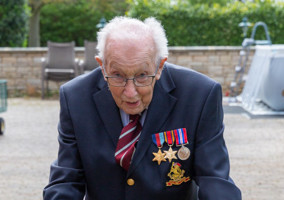Christmas is an essential period for fundraising. As charitable giving surges during the season of goodwill, teams see the fruition of months of strategising – developing concepts, refining messaging, and planning optimum market impact and reach. It is crucial that a charity’s campaign grabs the public’s attention and can be heard above competing causes and the clamour of commerce. This year, after months of lockdown and diminishing income, the pressure is really on to deliver a bumper Christmas campaign.
“We are expecting this to be a really competitive Christmas not only within the sector, but across the country, from business to retail, to hospitality to travel,” says Richard Lee, director of fundraising at Crisis, which raised £28m last year and has seen a 20% growth in income from its Christmas campaigns over the last two years. “We are all looking for a good Christmas. For a lot of businesses, if they don’t have a good Christmas, they are going to struggle in 2021. Charities are in a similar position.”
For many charitable organisations, the Christmas season provides funds that can underpin services for the rest of the year. Charity Commission and YouGov research published at the end of last year suggested that one in three households planned to give to charity over Christmas, and year after year November and December remain the peak periods for giving in the UK, according to the Charities Aid Foundation’s UK Giving Report.
“Christmas is an incredibly important fundraising opportunity for us – the biggest on the calendar,” says Polly Bianchi, head of supporter acquisition at WWF. In addition to animal adoptions and memberships, the charity has also launched a number of new product collaborations for Christmas via its online shop – most recently with author and illustrator Charlie Mackesy. “Gift purchases throughout the festive season generate crucial income for WWF. It’s certainly been a challenging year and, for most of us, the festive period will feel somewhat different.”
Fundraising in Covid
It is hard to judge how different it is going to be in terms of fundraising, but one thing is for sure: this year, charities need the festive spike in generosity more than ever. With charities predicting falls of income of anywhere between 50% to 80%, the sector as a whole may stand to lose more than £4bn due to the coronavirus pandemic.
Moreover, the festive fundraising landscape is completely unrecognisable from previous years, as mass participation events, face-to-face and street fundraising are out of the picture due to Covid restrictions.
“In previous years, our main fundraising income has come through events,” says the head of fundraising at Birmingham Dogs Home, Fi Harrison. “Our annual Christmas event, Santa Paws, raises a decent amount of money and engages the whole community.
“But none of our events happened this year, so we have lost something in the region of £50,000.”
Even for those charities that managed to maintain income over recent months, Christmas is still a critical time. “March through May, our donors were hugely supportive,” says Lee. “Our campaigns have delivered as we had expected, or even slightly exceeded expectations. But there is a lot of uncertainty going into this Christmas period, with furlough continuing, redundancies and on top of that Brexit. Our Christmas campaign has been incredibly successful in the past, but this year, we have reduced our expectations by about £5m in terms of income. Although we have also reduced spend, so it should balance out.”
Strategic moves
The exceptionally unusual circumstances have meant charities have had to review their timings and promotional strategy. “We went out with our print campaign a couple of weeks earlier this year,” says Lee at Crisis, whose charity began newspaper inserts in early November. “We wanted to raise awareness gradually in the lead up to Christmas so that people had more time to consider a gift when the choices may be harder for them. At the beginning, I wondered whether we should have cancelled some print, but actually I’m really pleased we didn’t, as I think door drops and inserts are probably going to have a good year this year because they’ll have more impact.”
To maintain the relevance of its festive campaign, Birmingham Dogs Home revamped its Christmas dinner appeal, which helps provide warm meals to homeless dogs during the festive season. A new messaging and promotion strategy links the appeal with the current crisis through the tagline: “It’s been a ruff year”.
Harrison explains: “We’ve introduced different calls to action, so potential donors can either become a friend and sign up by direct debit, or you can donate by text, as well as using all the usual online methods. As it’s a pilot, we are also doing cold door drops and direct mail to a limited number of postcode areas, which we haven’t done before.”
Digital first
With many marketing budgets already allocated by January, digital has come into its own for tweaking or reshaping existing strategies during these rapidly changing times.
“We’ve focused on creating powerful digital and TV assets, and content that will enable us to effectively engage online with existing and prospective supporters,” says Bianchi at WWF. The charity launched its Christmas advert with a 60-second spot during the Pride of Britain awards on ITV at the start of November, followed by other 30-second spots on ITV, Sky, Channel 4 and on-demand channels. “This is particularly important in the absence of physical events and face-to-face fundraising, which would usually form a key part of our community engagement and brand awareness activity.
“Our ongoing promotion of the campaign includes digital activity across social media and display channels such as Facebook, Instagram, Snapchat and YouTube.” Viewers of the digital content can click through to a landing page on the charity’s website to discover more content, information and stories about its work and how they can help. “We are also using podcast sponsorship for the first time this year to reach new audiences,” adds Bianchi.
Lee at Crisis says the homelessness charity is also focusing a lot more on digital. “We are still running a TV campaign, but we have looked more at our digital journeys, because those are the ones we can swap and change and react to uncertainty,” he says. “And I think that continues to be the challenge of how we respond and keep donor-centric, honest and transparent. You don’t want to spend loads of extra money updating the messaging in response to the changing circumstances. Digital allows us to do that cost-effectively.”
Adapting to virtual
For others that relied heavily on events, adapting their Christmas campaigns to the virtual realm has been critical.
At the beginning of the year, Child.org was had significant success with its themed quiz nights but was forced to move online as lockdown hit. It has now applied what it learnt from that process to its festive campaign. “It occurred to us that it was unlikely anyone was going to go back into the office by Christmas, so we recognised a gap in the market where we could provide a service and raise funds,” says partnerships and projects manager Amanjit Dhillon.
The global child health organisation hit upon the idea of hosting virtual Christmas parties for corporates. Starting from £20 per person, the bespoke Big Fat Christmas package “provides all the little extras to recreate the office party experience online”, including a professional host, a quiz, creative challenges, team games, Christmas cocktail recipes, festive Zoom backgrounds and Spotify Christmas playlists.
With 10 companies signed up at press time, proceeds from packages will fund Child.org’s child health programmes in Kenya and Sierra Leone. “We are aiming to get 30 companies and make between £5,000-£10,000. That’s how much we would usually make from a Christmas campaign.”
Participants can make a donation during the evening, but it is a very soft ask with the charity maintaining a low-profile. “Typically Christmas campaigns focus heavily on storytelling or images around the projects that need funding because people want to give something back at this time of year,” explains Dhillon. “This year, we thought it would be a tricky time to be making an ask of that kind. We decided it would be better to offer a service or product, as many companies will have struggled during the pandemic. Corporates are happy to work with us because they are getting something out of it, as well as doing something to help a good cause.”
Power of positivity
This softer approach to messaging has been a common theme among this year’s campaigns.
Although still focusing on the plight of the homeless at Christmas, Crisis included a line in its messaging saying that the charity understands that people might not be able to give this year. “It’s really important to remember the journey of our donors and keep that at the forefront,” says Lee. “We have to accept that they might not be able to help us this year, not because they don’t want to, but because life has thrown them a series of curveballs.”
Another common element of the messaging has been to try to focus on the positive. Bianchi at WWF says: “While the events of 2020 have brought about times of hardship for many, they have also highlighted the power of togetherness and the importance of home. It is these positive sentiments that we wanted to capture in our Christmas campaign.”
Looking forward to the festive period, Lee says that he feels positive but remains realistic. “There are significant opportunities in this period of change, as well as challenges. I could make the argument for why this is going to be our best Christmas ever. But I could also make the case for why it is going to be really challenging. No one really knows.”
Virtual Christmas campaigns – Guide Dogs
With Guide Dogs forecasting a shortfall in fundraising income of around £3m, the charity’s Christmas campaigns are particularly critical this year. Alongside the 12 Guide Dogs of Christmas appeal and the Christmas raffle, the charity has also introduced a line of new gifts at its online shop. Gifts range from paw-print face masks to advent calendars, cuddly toys and jewellery, and cost anywhere from £7 to £95.
There will also be a virtual Christmas Wishes event and online auction that will run until 12 December, as well as a virtual walking challenge called 100 for Guide Dogs, where supporters can complete their own distance or time target to raise funds.
“We are not running a one-hat-fits-all campaign across all of our audiences this year,” says director of fundraising at Guide Dogs, Maria Novell. “What we’ve done instead is taken what we’ve learnt about donor behaviour since Covid – whether that’s through results that we’ve seen on previous activity this year or market research that’s come out – and adapted or created campaigns accordingly for the different groups.
“What’s probably most different this year is the messaging. We are not running a Covid appeal, but we are acknowledging Covid and our shared experience. One thing we’ve really noticed through this time is the awareness that disability can be isolating. People who are blind can be isolated, and a lot of people felt isolated during Covid. So people’s understanding and appreciation for that is probably higher than it has ever been.”
Give a little love – Waitrose and John Lewis
Waitrose and John Lewis’s Christmas TV advertising, which launched in November, is one element of a major campaign by the two retailers under the strapline “Give a little love”.
Together John Lewis and Waitrose are aiming to raise £4m for two charities: FareShare, which helps those facing food poverty, and Home-Start, which works with parents who need support.
The two-minute ad is designed to inspire the nation to give a little love to those around them, while a complimentary 30-second ad carries a direct call to support the two charities. Customers are encouraged to give in different ways, including: making a charity donation; buying campaign products with 100% of profits donated to the charities; and using their loyalty card to increase the partnership’s donation.
Customer donations up to the value of £2m will be match funded by a donation from the John Lewis Partnership. A further fund of over £1m has also been created to ensure all of the retailers’ shops will be actively partnering with FareShare, Home-Start and a range of local family charities in the communities they serve.
Since the pandemic broke out, the partnership has committed £2.7m to charities and local communities. This has included designing and producing products ranging from face coverings to mugs and bags in order to raise funds in aid of NHS Charities Together.












